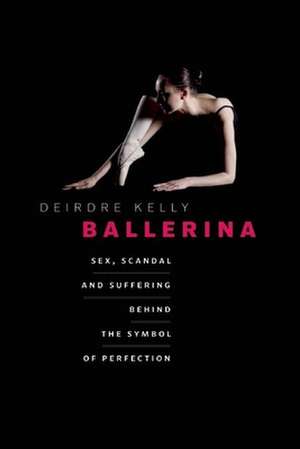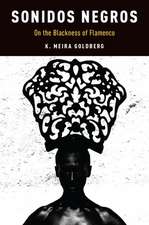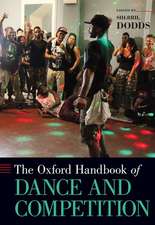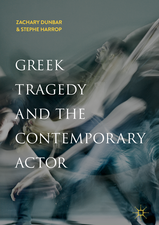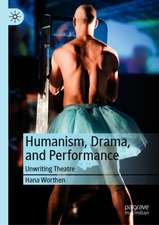Ballerina: Sex, Scandal, and Suffering Behind the Symbol of Perfection
Autor Deirdre Kellyen Limba Engleză Paperback – 25 feb 2014
Throughout her history, the ballerina has been perceived as the embodiment of beauty and perfection — she is the feminine ideal. But the reality is another story. Beginning with the earliest ballerinas, who often led double lives as concubines, Deirdre Kelly goes on to review the troubled lives of 19th-century ballerinas, who lived in poverty and worked under torturous and even life-threatening conditions. In the 20th century, George Balanchine created a contradictory ballet culture that simultaneously idealized and oppressed ballerinas, and many of his dancers suffered from anorexia and bulimia or underwent cosmetic surgery to achieve the ideal ethereal form. At the beginning of the 21st century, ballerinas are still underpaid, vulnerable to arbitrary discrimination and dismissal, and expected to bear pain stoically — but much of this is beginning to change. As Kelly examines the lives of some of the world's best ballerinas, she argues for a rethinking of the world's most graceful dance form — a rethinking that would position the ballerina at its heart, where she belongs. Highlighting the work of such great ballerinas such as Anna Pavlova, Isadora Duncan, Suzanne Farrell, Gelsey Kirkland, and Evelyn Hart Kelly illustrates how the world of ballet is slowly evolving.
Preț: 113.19 lei
Nou
Puncte Express: 170
Preț estimativ în valută:
21.66€ • 22.67$ • 17.92£
21.66€ • 22.67$ • 17.92£
Carte disponibilă
Livrare economică 15-29 martie
Preluare comenzi: 021 569.72.76
Specificații
ISBN-13: 9781771640008
ISBN-10: 1771640006
Pagini: 264
Ilustrații: B&W photos
Dimensiuni: 152 x 229 x 23 mm
Greutate: 0.41 kg
Editura: Grey Stone Books
Colecția Greystone Books
Locul publicării:Canada
ISBN-10: 1771640006
Pagini: 264
Ilustrații: B&W photos
Dimensiuni: 152 x 229 x 23 mm
Greutate: 0.41 kg
Editura: Grey Stone Books
Colecția Greystone Books
Locul publicării:Canada
Recenzii
"...fast-paced and fascinating...a pleasurable read for any balletomane." — Library Journal
"...spellbinding yet harrowing..." — Publishers Weekly
"Kelly exposes, with rich detail, the underbelly of the world that only those with a true calling to dance en pointe could endure. ...Read this book. You will never look at a ballet production through the same eyes again." — Portland Book Review
"...spellbinding yet harrowing..." — Publishers Weekly
"Kelly exposes, with rich detail, the underbelly of the world that only those with a true calling to dance en pointe could endure. ...Read this book. You will never look at a ballet production through the same eyes again." — Portland Book Review
Notă biografică
Deirdre Kelly is a journalist, author, and internationally recognized dance critic for Dance Magazine, the Dance Gazette, and the Globe and Mail, where for sixteen years she was the paper's dance critic on staff. A contributor to the International Dictionary of Ballet and the online arts group Critics at Large, she is the author of the bestselling memoir Paris Times Eight. Her articles on dance have also appeared in Elle, Vogue, Chatelaine, and Saturday Night. She lives in Toronto, ON.
Extras
BALLERINA --- AN INTRODUCTION
The ballerina is the delectable delight at the center of the sumptuous visual feast that is the ballet. For some, she is the art form’s bread and butter; for others, she is its sinfully rich dessert. Either way, the ballerina satisfies a variety of tastes for the connoisseur and occasional nibbler alike. From the sugary sweetness of her popular jewel-box image to the saltiness embodied by her carefully molded, highly eroticized flesh, the ballerina appears in the popular imagination as a painstakingly prepared dish for cultural consumption. It’s what makes her an enigma among woman: a flesh-and-blood object of desire who as a result of an intense training, dieting and almost 400-years of strict etiquette is also a disembodied creature, more fantastical than real.
She floats on air, rising into the ether, and is variously a swan, sylph or spirit haunting our imaginations from beyond the grave. Throughout her history (and a relatively brief one considering that men dominated the art of ballet from its origins in the courts of the Renaissance until the Romantic Era, when the cult of the ballerina took flight), the ballerina has been perceived as an otherworldly creature, beyond human. Dancing in hard-tipped shoes that literally lift her above the earth, she appears to occupy a realm beyond that of the everyday. Historic lithographs of Romantic ballerinas show them with elongated necks, boneless arms and flesh as pale and translucent as the wings pinned to their backs. The ballerina comes across as a kind of feminine ideal, unblemished and ethereal, inspiration incarnate.
But the reality on the other side of the curtain is another story. The origins of the ballerina are mired in poverty and sexual exploitation. Throughout her history the ballerina has had to suffer enormous deprivation to maintain the ideal of the classical dancer as a symbol of perfection, enduring pain, frequent humiliation and even starvation to create the illusion of weightlessness on stage.
From her beginnings as a dance professional in the 16th century and continuing until today, the ballerina’s role and identity within Western civilization has been shaped by forces that go beyond that of mere art. As much as an aesthetic symbol, the ballerina is also a social construct, a complex product of her time and place. If, as British sociologist Bryan S. Turner says, the body is the site of incorporated history, then the ballerina’s body is the incorporated site of ballet history. In the words of pioneering American ballet dancer Agnes DeMille, “Theatre always reflects the culture that produces it,” an observation that is true also of the ballerina. Since the beginning, she has mirrored local conditions contributing to the production of art and historically specific ideas governing her role and identity within society as a professional woman of the theatre.
But what were those conditions? What social practices and attitudes turned her into a type of idealized female in the first place? How is that she appears to personify the dichotomy of spirit and flesh? What makes this wing-backed creature, an archetype in the popular imagination, so fascinatingly inscrutable?
The answers lie in the dual existence of the ballerina. Certainly there is something disturbingly schizophrenic about her identity. She appears, at first glance, a woman publicly adulated, the star of her particular show, a kind of ur-woman standing strong and statuesque on the steely tips of her pointe shoes. But behind-the-scenes, she is subtly degraded. She has devoted herself to her art from childhood, training her body away from its natural forms and curves to dance what, in essence, is an intricately patterned distortion of the body: flesh as artifice. And yet historically, she has never been duly respected or compensated for all her years of hard work and devotion to ballet. She has always been the worst paid artist in her society, subsisting dangerously close to the poverty line. That situation has hardly changed over the years: in Canada in 2001 she still ranked at the bottom of the professional artist totem pole, earning on average an annual salary of just under $10,000, a figure well below the $18,000 low-income cut-off figure for a single person living in a community of 500,000 or more, according to census data compiled by Statistics Canada.
Her lowly economic status within society has often compelled ballerinas to make choices that compromise her dignity as a human being in order to survive. It has made her vulnerable to exploitation by those of more means, in particular wealthy and socially powerful men. This is on top of the daily threat of injury imposed on her by the increased athleticism required by ballet, especially in the 21st century, and an ever diminishing age of retirement as a result of the attrition with which ballet increasingly afflicts her body. Add to this anorexia nervosa, incidents of which are higher in this sub-culture of females than in any other segment of the population. Some reports say that at least 15 per cent of all ballerinas are affected by an eating disorder as a direct result of their profession. Ballet diminishes, and in some cases maims and kills, the very dancers it elevates on pedestals of high choreographic art. When she suffers for her art—and many ballerinas throughout history have suffered in a myriad of ways—then the expectation is that she tolerate her pain stoically, soldier on in silence or else risk being ostracized from the hermetic sisterhood to which she has sacrificed the bulk of her youthful life. “It’s a terribly short career,” says Bridgett Zehr, a new generation ballerina with the English National Ballet in London. “You are always aware that it will be over before you are ready to say good-bye.”
The eternal feminine has a shelf-life, in other words; it’s just one of many ironies casting a shadow over the image of the ballerina in our society. On the surface, the ballerina appears in control, but in reality she is controlled—by teachers, directors, choreographers (most often men), by societal expectations regarding her role as a representative of divinely patterned grace here on earth, and by ballet itself, an art with centuries of rules and regulations governing everything from body positions to etiquette built right into it. The ballerina’s two-pronged existence, as defined by the tension between her private and public lives, is not unlike the twin White Swan/Black Swan roles danced by a single ballerina in Swan Lake, the world’s best-loved ballet. As the Swan Queen Odette dressed in pale tights and feathery white tulle, manifestations of the ballet blanc supporting her etherealized image, the ballerina appears chaste and beyond reproach, a feminine ideal existing beyond the reach of human desire. As her wicked twin Odile, she is the ultimate seductress, manipulated by dark forces from behind the scenes which make the ballerina appear more sinister than she at first seems. It is this backstage view that fascinates—the beastliness hidden behind the satin and sequins, and excused in the name of beauty. It’s point of view explored by the 2010 Hollywood film, Black Swan, which showed the backstage world of ballet as a twisted hall of mirrors where ballet’s so-called prettiness was grotesquely reflected back on itself as a life of horror. This contemporary vision of ballet’s backroom drama contrasts sharply with the image of ballet offered up two decades earlier by A Chorus Line, an earlier pop culture phenomenon with wide-spread audience appeal which similarly used the competitive world of professional dance as a means of exploring the psychological complexities of its performers: “Everything is beautiful at the ballet,” pronounced the starry-eyed ingénue. But is it? Even a cursory look at the art form suggests that ballet is more sweat than sweet. The ballerina herself is always more than what meets the eye. Her true essence lies somewhere in between the light and the dark.
To get a better understanding of this most enigmatic of females, a specialized sub-class of occupational worker, the following narrative presents a backstage history of the ballerina, starting with her rarefied origins in the French court of Louis XIV when the first recorded ballerinas appear on the scene, and concluding with a look at ballerinas as workers in the decidedly unglamorous world of the professional ballet company, today.
Several themes emerge: one is that the ballerina is the embodiment of a culture of manners, a leftover from ballet’s origins as a courtly entertainment in monarchical Europe. Even today, ballerinas are expected to behave with decorum and appear as if innately elegant and graceful. Ballerinas who deviate from ballet’s norms are ostracized, ridiculed and excluded from doing the one thing they have trained themselves for—to dance ballet. A second theme concerns the ballerina’s role as property; throughout her history, and lasting until the present day, she has been owned by men, the state, her art and, more recently, artistic directors and choreographers who claim it is their work, their genius, that bestow beauty upon the ballerina. A third theme revolves around the ballerina’s relationship to the labour of ballet. The art peddles in beauty but it is a beauty manufactured much like designer label clothing produced in Third World sweatshops, in often dehumanizing conditions. Historical accounts from the 19th century describe dank, windowless, rat-infested studios condemned by public health authorities as warrens of consumptive disease. In the present day, studios might be scrubbed clean of vermin, but the lack of a consistently applied labour laws means that ballerinas are vulnerable to arbitrary discrimination and dismissal at a time when most other workplaces in the Western world are regulated by legislation based on a fundamental respect for human rights. Throughout history, there has been such a thing as a safe ballerina.
Underlying the complicated history of the ballerina is the pervasive notion of sacrifice, a theme of so many ballet classics such as Swan Lake and Gisele, but also, less obviously, The Sleeping Beauty and The Nutcracker (a seemingly benign ballet based, however, on a E.T.A Hoffmann’s coming-of-age story about a girl who learns to relinquish her toys if she wants to grow up to dance with a Prince). Ballerinas are conditioned from a young age to accept self-sacrifice as an integral part of the art form. Ballerinas in training must learn to work through the pain, from childhood until the end of their days as dancers when mature women. They learn to numb the pain with drugs and other inhibitors; after their performances, they reach for buckets of ice in which to soak their swollen, gnarled and bleeding feet, seeking relief from the agonies of having danced in pointe shoes. Ballerinas everywhere sacrifice themselves on the burning pyre of their art, some quite literally, as shall be seen.
When they suffer for their art—and many ballerinas throughout history have suffered in a variety of ways—the expectation is that she tolerates her pain stoically, and in silence. If she dares speak up she risks being ostracized from the hermetic sisterhood to which she has committed her life. One ballet’s great source of shame is how often ballerinas are mistreated and then expected to carry on, as if nothing bad has happened. It’s a pattern of negative behaviour that appears part and parcel of the unnaturalness of ballet. Bodies aren’t made to stand on one leg to six counts of music; bodies are rather taught how to perform such physically taxing feats without strain and without a whimper. Pain is denied, or at least its expression. An art form founded on the stiflement of discomfort has produced a culture where deprivation and degradation are allowed to flourish because it is seen to yield super-human results: to wit, standing on one leg to six counts of music.
But those performing the tricks have had to compromise themselves as individuals in support of such anti-gravitational illusions. Ballerinas, in particular, have been expected to subsume their wants and needs to keep ballet flourishing. They give their all and then in the end, when the curtain falls on their last performance, they are pushed out into the cold, soon forgotten. It’s why the ballerina’s life, seen from afar, looks like a balancing on the edge of a precipice, fraught with danger and the understanding that one false move and, splat, it’s finished. “It’s a terribly short career,” allows Bridgett Zehr, a twentysomething ballerina currently performing a principal dancer with with the English National Ballet. “You are always aware that it will be over before you are ready to say good-bye.”
Such is the gritty behind-the-scenes world of the ballet which is rooted in what one scholar has called a fairly perverse social order.[viii] The perversities are often defended as beauty, even by the victims themselves. The end justifies the means according to Suki Schorer, a former New York City Ballet dancer under George Balanchine, and later a leading teacher at the School of American Ballet. She was once asked why a student jumped without putting down her heel—doesn’t it cause tendinitis? “Yes,” Schorer smiled, “when people come into this company they get tendinitis—but it’s beautiful.”
But some of that thinking has changed. Ballet shows evidence that it is becoming more in step with the 21st century in becoming more sensitive to dancers as individuals with constitutionally protected rights. Ballerinas are today having babies; they are even gaining weight as a means of protecting their bodies from repetitive injuries and prolonging their careers. Science is even ponying up to the barre to help dancers become more recognized as the elite athletes they are. There’s more job protection and even, in places, better wages. But as the ballerina progresses so does the art form. Choreography today is more athletic and acrobatic than it was even 20 years ago. This is putting the ballerina before a new set of risks: one step forward, two steps back.
The ballerina is the delectable delight at the center of the sumptuous visual feast that is the ballet. For some, she is the art form’s bread and butter; for others, she is its sinfully rich dessert. Either way, the ballerina satisfies a variety of tastes for the connoisseur and occasional nibbler alike. From the sugary sweetness of her popular jewel-box image to the saltiness embodied by her carefully molded, highly eroticized flesh, the ballerina appears in the popular imagination as a painstakingly prepared dish for cultural consumption. It’s what makes her an enigma among woman: a flesh-and-blood object of desire who as a result of an intense training, dieting and almost 400-years of strict etiquette is also a disembodied creature, more fantastical than real.
She floats on air, rising into the ether, and is variously a swan, sylph or spirit haunting our imaginations from beyond the grave. Throughout her history (and a relatively brief one considering that men dominated the art of ballet from its origins in the courts of the Renaissance until the Romantic Era, when the cult of the ballerina took flight), the ballerina has been perceived as an otherworldly creature, beyond human. Dancing in hard-tipped shoes that literally lift her above the earth, she appears to occupy a realm beyond that of the everyday. Historic lithographs of Romantic ballerinas show them with elongated necks, boneless arms and flesh as pale and translucent as the wings pinned to their backs. The ballerina comes across as a kind of feminine ideal, unblemished and ethereal, inspiration incarnate.
But the reality on the other side of the curtain is another story. The origins of the ballerina are mired in poverty and sexual exploitation. Throughout her history the ballerina has had to suffer enormous deprivation to maintain the ideal of the classical dancer as a symbol of perfection, enduring pain, frequent humiliation and even starvation to create the illusion of weightlessness on stage.
From her beginnings as a dance professional in the 16th century and continuing until today, the ballerina’s role and identity within Western civilization has been shaped by forces that go beyond that of mere art. As much as an aesthetic symbol, the ballerina is also a social construct, a complex product of her time and place. If, as British sociologist Bryan S. Turner says, the body is the site of incorporated history, then the ballerina’s body is the incorporated site of ballet history. In the words of pioneering American ballet dancer Agnes DeMille, “Theatre always reflects the culture that produces it,” an observation that is true also of the ballerina. Since the beginning, she has mirrored local conditions contributing to the production of art and historically specific ideas governing her role and identity within society as a professional woman of the theatre.
But what were those conditions? What social practices and attitudes turned her into a type of idealized female in the first place? How is that she appears to personify the dichotomy of spirit and flesh? What makes this wing-backed creature, an archetype in the popular imagination, so fascinatingly inscrutable?
The answers lie in the dual existence of the ballerina. Certainly there is something disturbingly schizophrenic about her identity. She appears, at first glance, a woman publicly adulated, the star of her particular show, a kind of ur-woman standing strong and statuesque on the steely tips of her pointe shoes. But behind-the-scenes, she is subtly degraded. She has devoted herself to her art from childhood, training her body away from its natural forms and curves to dance what, in essence, is an intricately patterned distortion of the body: flesh as artifice. And yet historically, she has never been duly respected or compensated for all her years of hard work and devotion to ballet. She has always been the worst paid artist in her society, subsisting dangerously close to the poverty line. That situation has hardly changed over the years: in Canada in 2001 she still ranked at the bottom of the professional artist totem pole, earning on average an annual salary of just under $10,000, a figure well below the $18,000 low-income cut-off figure for a single person living in a community of 500,000 or more, according to census data compiled by Statistics Canada.
Her lowly economic status within society has often compelled ballerinas to make choices that compromise her dignity as a human being in order to survive. It has made her vulnerable to exploitation by those of more means, in particular wealthy and socially powerful men. This is on top of the daily threat of injury imposed on her by the increased athleticism required by ballet, especially in the 21st century, and an ever diminishing age of retirement as a result of the attrition with which ballet increasingly afflicts her body. Add to this anorexia nervosa, incidents of which are higher in this sub-culture of females than in any other segment of the population. Some reports say that at least 15 per cent of all ballerinas are affected by an eating disorder as a direct result of their profession. Ballet diminishes, and in some cases maims and kills, the very dancers it elevates on pedestals of high choreographic art. When she suffers for her art—and many ballerinas throughout history have suffered in a myriad of ways—then the expectation is that she tolerate her pain stoically, soldier on in silence or else risk being ostracized from the hermetic sisterhood to which she has sacrificed the bulk of her youthful life. “It’s a terribly short career,” says Bridgett Zehr, a new generation ballerina with the English National Ballet in London. “You are always aware that it will be over before you are ready to say good-bye.”
The eternal feminine has a shelf-life, in other words; it’s just one of many ironies casting a shadow over the image of the ballerina in our society. On the surface, the ballerina appears in control, but in reality she is controlled—by teachers, directors, choreographers (most often men), by societal expectations regarding her role as a representative of divinely patterned grace here on earth, and by ballet itself, an art with centuries of rules and regulations governing everything from body positions to etiquette built right into it. The ballerina’s two-pronged existence, as defined by the tension between her private and public lives, is not unlike the twin White Swan/Black Swan roles danced by a single ballerina in Swan Lake, the world’s best-loved ballet. As the Swan Queen Odette dressed in pale tights and feathery white tulle, manifestations of the ballet blanc supporting her etherealized image, the ballerina appears chaste and beyond reproach, a feminine ideal existing beyond the reach of human desire. As her wicked twin Odile, she is the ultimate seductress, manipulated by dark forces from behind the scenes which make the ballerina appear more sinister than she at first seems. It is this backstage view that fascinates—the beastliness hidden behind the satin and sequins, and excused in the name of beauty. It’s point of view explored by the 2010 Hollywood film, Black Swan, which showed the backstage world of ballet as a twisted hall of mirrors where ballet’s so-called prettiness was grotesquely reflected back on itself as a life of horror. This contemporary vision of ballet’s backroom drama contrasts sharply with the image of ballet offered up two decades earlier by A Chorus Line, an earlier pop culture phenomenon with wide-spread audience appeal which similarly used the competitive world of professional dance as a means of exploring the psychological complexities of its performers: “Everything is beautiful at the ballet,” pronounced the starry-eyed ingénue. But is it? Even a cursory look at the art form suggests that ballet is more sweat than sweet. The ballerina herself is always more than what meets the eye. Her true essence lies somewhere in between the light and the dark.
To get a better understanding of this most enigmatic of females, a specialized sub-class of occupational worker, the following narrative presents a backstage history of the ballerina, starting with her rarefied origins in the French court of Louis XIV when the first recorded ballerinas appear on the scene, and concluding with a look at ballerinas as workers in the decidedly unglamorous world of the professional ballet company, today.
Several themes emerge: one is that the ballerina is the embodiment of a culture of manners, a leftover from ballet’s origins as a courtly entertainment in monarchical Europe. Even today, ballerinas are expected to behave with decorum and appear as if innately elegant and graceful. Ballerinas who deviate from ballet’s norms are ostracized, ridiculed and excluded from doing the one thing they have trained themselves for—to dance ballet. A second theme concerns the ballerina’s role as property; throughout her history, and lasting until the present day, she has been owned by men, the state, her art and, more recently, artistic directors and choreographers who claim it is their work, their genius, that bestow beauty upon the ballerina. A third theme revolves around the ballerina’s relationship to the labour of ballet. The art peddles in beauty but it is a beauty manufactured much like designer label clothing produced in Third World sweatshops, in often dehumanizing conditions. Historical accounts from the 19th century describe dank, windowless, rat-infested studios condemned by public health authorities as warrens of consumptive disease. In the present day, studios might be scrubbed clean of vermin, but the lack of a consistently applied labour laws means that ballerinas are vulnerable to arbitrary discrimination and dismissal at a time when most other workplaces in the Western world are regulated by legislation based on a fundamental respect for human rights. Throughout history, there has been such a thing as a safe ballerina.
Underlying the complicated history of the ballerina is the pervasive notion of sacrifice, a theme of so many ballet classics such as Swan Lake and Gisele, but also, less obviously, The Sleeping Beauty and The Nutcracker (a seemingly benign ballet based, however, on a E.T.A Hoffmann’s coming-of-age story about a girl who learns to relinquish her toys if she wants to grow up to dance with a Prince). Ballerinas are conditioned from a young age to accept self-sacrifice as an integral part of the art form. Ballerinas in training must learn to work through the pain, from childhood until the end of their days as dancers when mature women. They learn to numb the pain with drugs and other inhibitors; after their performances, they reach for buckets of ice in which to soak their swollen, gnarled and bleeding feet, seeking relief from the agonies of having danced in pointe shoes. Ballerinas everywhere sacrifice themselves on the burning pyre of their art, some quite literally, as shall be seen.
When they suffer for their art—and many ballerinas throughout history have suffered in a variety of ways—the expectation is that she tolerates her pain stoically, and in silence. If she dares speak up she risks being ostracized from the hermetic sisterhood to which she has committed her life. One ballet’s great source of shame is how often ballerinas are mistreated and then expected to carry on, as if nothing bad has happened. It’s a pattern of negative behaviour that appears part and parcel of the unnaturalness of ballet. Bodies aren’t made to stand on one leg to six counts of music; bodies are rather taught how to perform such physically taxing feats without strain and without a whimper. Pain is denied, or at least its expression. An art form founded on the stiflement of discomfort has produced a culture where deprivation and degradation are allowed to flourish because it is seen to yield super-human results: to wit, standing on one leg to six counts of music.
But those performing the tricks have had to compromise themselves as individuals in support of such anti-gravitational illusions. Ballerinas, in particular, have been expected to subsume their wants and needs to keep ballet flourishing. They give their all and then in the end, when the curtain falls on their last performance, they are pushed out into the cold, soon forgotten. It’s why the ballerina’s life, seen from afar, looks like a balancing on the edge of a precipice, fraught with danger and the understanding that one false move and, splat, it’s finished. “It’s a terribly short career,” allows Bridgett Zehr, a twentysomething ballerina currently performing a principal dancer with with the English National Ballet. “You are always aware that it will be over before you are ready to say good-bye.”
Such is the gritty behind-the-scenes world of the ballet which is rooted in what one scholar has called a fairly perverse social order.[viii] The perversities are often defended as beauty, even by the victims themselves. The end justifies the means according to Suki Schorer, a former New York City Ballet dancer under George Balanchine, and later a leading teacher at the School of American Ballet. She was once asked why a student jumped without putting down her heel—doesn’t it cause tendinitis? “Yes,” Schorer smiled, “when people come into this company they get tendinitis—but it’s beautiful.”
But some of that thinking has changed. Ballet shows evidence that it is becoming more in step with the 21st century in becoming more sensitive to dancers as individuals with constitutionally protected rights. Ballerinas are today having babies; they are even gaining weight as a means of protecting their bodies from repetitive injuries and prolonging their careers. Science is even ponying up to the barre to help dancers become more recognized as the elite athletes they are. There’s more job protection and even, in places, better wages. But as the ballerina progresses so does the art form. Choreography today is more athletic and acrobatic than it was even 20 years ago. This is putting the ballerina before a new set of risks: one step forward, two steps back.
